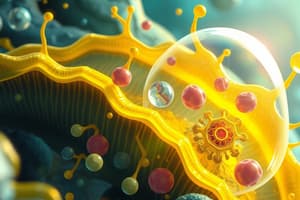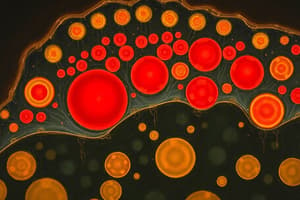Podcast
Questions and Answers
Which of the following statements about prokaryotes is accurate?
Which of the following statements about prokaryotes is accurate?
- They have a nucleus.
- They contain membrane-bound organelles.
- They belong to the domain Eukarya.
- They are classified as bacteria. (correct)
What is the primary function of ribosomes within a cell?
What is the primary function of ribosomes within a cell?
- Energy production.
- Cell division.
- Lipid storage.
- Protein synthesis. (correct)
In the context of cell membranes, what is the main role of cholesterol?
In the context of cell membranes, what is the main role of cholesterol?
- Providing structural support to phospholipids. (correct)
- Enhancing water permeability.
- Regulating cell division.
- Facilitating active transport.
Which transport mechanism involves movement across the cell membrane without the use of energy?
Which transport mechanism involves movement across the cell membrane without the use of energy?
Which organelle is responsible for energy production in eukaryotic cells?
Which organelle is responsible for energy production in eukaryotic cells?
What is the primary function of vacuoles in plant cells?
What is the primary function of vacuoles in plant cells?
Flashcards
Prokaryote
Prokaryote
A cell without a nucleus or other membrane-bound organelles. Examples include bacteria and archaea.
Eukaryote
Eukaryote
A cell with a nucleus and other membrane-bound organelles. Examples include animal, plant, fungal, and protist cells.
Cell Membrane
Cell Membrane
A selectively permeable barrier that surrounds the cell, regulating what enters and exits.
Passive Transport
Passive Transport
Signup and view all the flashcards
Osmosis
Osmosis
Signup and view all the flashcards
Mitochondria
Mitochondria
Signup and view all the flashcards
Study Notes
Cell Types
- Prokaryotes are bacteria
- Eukaryotes include animalia, plantae, protists, and fungi
Cell Structures
- Cell walls are present in some cells
- Ribosomes are involved in protein synthesis
- Cell membranes (plasma membranes) are lipid bilayers, semi-permeable
- Phospholipids are the major component of cell membranes
- Hydrophobic tails repel water
- Hydrophilic heads attract water
- Cholesterol supports phospholipids
- Proteins (channels) facilitate transport across membranes
Membrane Transport
- Passive transport moves substances from high (H) to low (L) concentration without energy
- Simple diffusion is the movement of any substance from high to low concentrations
- Facilitated diffusion uses a protein channel for substance movement from high to low concentrations
- Osmosis is the movement of water from high to low concentrations
- Active transport moves substances from low (L) to high (H) concentrations using energy
Organelles
- Mitochondria are found only in eukaryotic cells, producing energy.
- Vacuoles are storage compartments, common in eukaryotes, especially plants.
- Chloroplasts are found in eukaryotes and contain chlorophyll.
- Endoplasmic reticulum (rough and smooth) is part of a cell's internal transport system.
- Lysosomes are involved in intracellular digestion
- Golgi apparatus processes and packages proteins
Studying That Suits You
Use AI to generate personalized quizzes and flashcards to suit your learning preferences.




